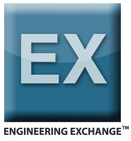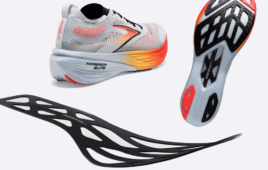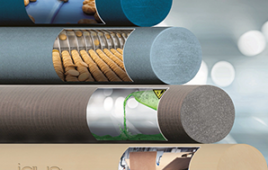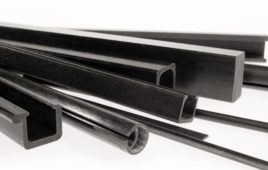Here are a few that target optical enhancement and processing improvements for packaging, automotive, and technical applications. They are being sold as unique offerings that can reduce energy consumption and promote more cost-effective production.

This image shows a material used for heat dissipation for semiconductor devices.
Increasingly, sustainability through additive innovations is central to the many new materials coming to market. At the upcoming K 2010 exhibition in Düsseldorf Milliken Chemical will display its Millad clarifying agents that yield aesthetic properties that the company said were never seen before in polypropylene (PP). They are complemented by ClearTint polymeric colorants that put bright colors into plastics without compromising clarity or processability.
Also in the company’s line-up are new developments to its range of Hyperform nucleating agents. These are said to deliver improvements in performance and processability in polypropylene and polyethylene (PE).
Milliken will highlight the energy savings and clarity made possible by the addition of Millad NX8000 to PP. The company says that numerous trials carried out since the product’s launch are proving that the additive delivers best-yet clarity for PP and can regularly yield cycle time reductions of as much as 15%.
With Millad NX8000, an injection molder normally processing polypropylene at 240-260°C can lower machine settings to approximately 200°C. This ability to process at reduced temperatures can cut energy consumption by 15 to 20%.
K 2010 visitors will be among the first to see a new version of the additive aimed specifically at extrusion-blow molding, Millad NX8500E. Set for launch in 2010, this material will allow processors to optimize surface properties and bulk haze. Bottles produced with this material will exhibit gloss and transparency, making them suitable for use in many applications.
Milliken’s ClearTint polymeric colorants maintain the transparency of polyolefins while producing a brighter color. As they have no effect on shrinkage, parts have a lower tendency to warp. Although ClearTint is particularly suitable for PP, it is also increasingly used in PE for packaging applications such as container lids.
Unlike more conventional dyes, ClearTint colorants have increased resistance to migration and therefore are ideal for food contact applications. Milliken also has a formulation that meets U.S. Pharmacopoeia pill vial regulations, which include limits on transmission of UV radiation by packaging. ClearTint U.S. Pharmacopoeia formulation for pill vials limits the amount of ultraviolet radiation absorption to protect vial contents and maintain the clarity of the container over its lifetime.
Milliken will also demonstrate new opportunities to fix problems facing manufacturers involved in many PP and PE molding processes with its Hyperform High Performance Nucleating (HPN) agents.
Benefits for typical applications include fine-tuning coefficient of linear thermal expansion (CLTE) in grades for automobile bumpers and instrument panels, cycle time reduction and warpage elimination in the production of pallets and crates, and increased processability and optic enhancement in packaging. Hyperform technologies can also enable PP to replace other resins, allowing for lighter weight parts, lower cost, and more consumer friendly products.
Easy to use, Hyperform products disperse well even in high melt flow resins where traditional nucleation technologies may not. In addition, with very fast crystallization performance, Hyperform nucleators allow molders to over-nucleate pigments for more consistent manufacturing and improved dimensional performance. Hyperform nucleating agents are also used in sheet and profile extrusion, such as pipe applications where they offer improved stiffness and runnability.
Highlights to be on display at K 2010 include a pioneering advance for PE with Hyperform HPN-20E. The product has a major impact on cycle time reduction, barrier properties in HDPE blow molding and film, and clarity improvements in C4 gas phase LLDPE.
Hyperform HPN-20E increases crystallization temperature and has an influence on crystal orientation. As a result, barrier to oxygen and moisture vapor is increased by as much as 20 to 50% depending on the PE resin technology. The higher crystallization temperature, combined with greater crystal orientation, allows bottles to be demolded earlier, cycle times reduced, and productivity increased. This product also said to improve seal strength and provide potential for material down-gauging of low density PE extrusion coating formulations.

The Hyperform high performance reinforcement products include HPR-803 specifically for the automotive market. The material helps automakers produce cars with reduced fuel consumption and lower vehicle emissions.
Hyperform High Performance
Reinforcement (HPR) family of products includes HPR-803, which was launched primarily for the automotive sector last year. It is a synthetic fiber additive that enables the production of PP compounds with mechanical performance similar to or better than mineral filled compounds, but at lower use-level and thus reduced weight. Added at levels typically one third of those for talc, Hyperform HPR-803 allows for parts that are 15% lighter, helping automakers produce cars with reduced fuel consumption and lower vehicle emissions. In addition to allowing reduced material usage, HPR-803 reinforced PP is more recycle-friendly, unlike glass fiber reinforced PP.
Aesthetics are also improved. Whiter in color than talc, the additive lets processors cut down on pigment usage to get the color they want. Parts containing the new reinforcing additive that have the same mechanical properties as glass fiber reinforced PP exhibit a noticeably better surface finish and also weatherability. For compounders, HPR-803 is generally easier to handle and is not as destructive to machinery when compared to chopped glass.
Silicones beat the heat
Shin-Etsu Silicones of America recently launched its TC-CA series. These products are comprised of the company’s advanced polymer and thermally conductive filler composite material technologies. The low-hardness silicone “soft pad” series of products have high thermal conductivity and good electrical insulation properties.

Using Millad NX8000, injection molders can lower machine processing temperatures to 200°C – reducing energy consumption by 15 to 20%.
The company says this new series offers good cost performance that meets the need for thinner and lighter weight electronic device applications such as those mounted in notebook PCs, LED lighting, and hybrid and electric cars. The soft pad materials allow better line-to-line contact between the heat sink and the heat generating component which means more heat transfer and longer life parts.
Product properties:
• Low hardness that makes for good compressibility
• Stress-relaxation property that can reduce stress to heat modules
• Excellent workability and processibility
• Low specific gravity
These heat-dissipating thermal interface materials are thermally conductive compounds fitted between the heat-generating unit; such as a computer’s CPU, and the heat sink. Depending on the application, it is possible to meet diverse heat-dissipation requirements as each product in the series offers a combination of properties which you can choose the most appropriate product based on specific application or usage conditions.
Discuss this on the Engineering Exchange:
Milliken Chemical
www.milliken.com
Shin-Etsu Silicones of America, Inc
www.shinetsusilicones.com
::Design World::
Filed Under: Automotive, Green engineering • renewable energy • sustainability, Semiconductor manufacture, Materials • advanced, Energy management + harvesting, Packaging





Tell Us What You Think!